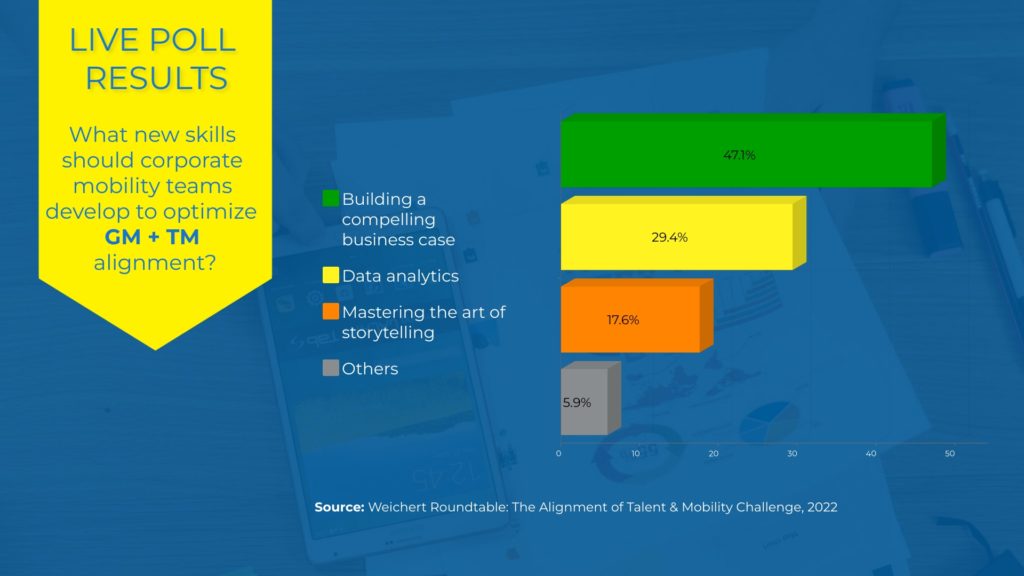
Talent management and global mobility are undeniably the power couple of 2022, and we’re placing our bets on this pair standing the test of time! Because we’re working in a uniquely different environment than we were three years ago. Talent shortages, remote work requests, compliance complexities, and rising inflation means that organizations worldwide need to be strategic and thoughtful about how to attract, develop, and retain employees — marrying talent management with global mobility can help companies to achieve all these objectives (and more!).
We recently hosted a roundtable with an inspiring lineup of companies and subject matter experts from the EMEA and APAC regions to glean insight into how these regions are positioning the mobility function to optimize its talent management capacity. The responses were illuminating and left us with plenty of food for thought, some of which we shared in the first installment of this blog post.
We are happy to share even more takeaways from this session, which speak to the critical need and varied global approaches to a GM + TM alignment:
The Need for Alignment is Intensified During Periods of Business Transformation
- A few stories were shared, and they spoke volumes about the critical need for alignment when an organization is navigating BIG changes.
- When a global US-headquartered tech company with a substantial APAC presence underwent a critical transformation 5 years ago, they needed to ensure they were attracting the right talent to an increasing number of locations. This need created the opportunity for mobility to align much more closely with talent, an opportunity that was embraced by both groups. The alignment that followed proved to be organic rather than forced, creating a much stronger foundation for the cross-functional collaboration that has followed.
- For an automotive sector leader, it was the significant overall organizational transformation they embarked on that led their global mobility function to think differently, recognizing that “if we stick with a business-as-usual approach, we’re at risk of becoming irrelevant”. The world of work is evolving, and so are employee needs. To attract, retain, and support the talent they wanted to attract (and keep), they needed to know what this talent valued, and ensure that this was being continuously reflected in their mobility programs and culture. Synergies with talent management can help this happen – proactively rather than reactively – to support the business and continually stay one step ahead.
Developing a Culture of Alignment Through Storytelling
- Understandably, any changes needed to better align a company’s talent management and global mobility functions can’t happen overnight; it’s important for global mobility to start telling the stories – like the ones detailed above – that shed light upon the true value of alignment. Storytelling is a powerful, but vastly underused tool – for not only sharing successes, but paving the way for change.
“It’s all about building your relationships, making those relationships deeper, clearly communicating what you’re doing, and also sharing the success stories with all business units that you might have from some business units”.
- Substantive changes required to promote better alignment between talent and mobility happen when multiple levels of the company – most notably, senior management – recognize the benefits to be derived from enhanced alignment, encouraging a view of mobility as a strategic value function and not merely a tactical one.
- When asked what new skills corporate mobility teams would need to develop in order to pursue (and optimize) a better integrated and aligned strategy for Mobility and Talent Management, corporate participants in the EMEA and APAC regions agreed upon “Building a Compelling Business Case” as the top skill. But storytelling is an important component of this, helping to more effectively influence stakeholders.

The time is now, mobility leaders. It’s no longer enough to have a GM function sitting on the sidelines, dealing solely with the logistical or tactical dimensions of workforce mobility. You’re in a great position to tell transformative stories and advocate for change, whether that means having GM operate separately or alongside a function – like talent management – that could help amplify its value to the organization. There is no ideal alignment model that will work for every organization but investing the time into boldly exploring new strategies can help fuel your defense against the war for talent.
Keen to dive deeper into regional workforce mobility trends? Talk to us!